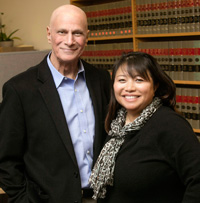San Francisco attorneys lend collaborative skills in policing
practices
 |
| Sharon Woo and Tom Meyer |
By Sharon Woo and Tom Meyer
Ever since Michael Brown's death in Ferguson, Missouri in
August 2014, the nation has been on edge.
When the Bar Association of San Francisco’s (BASF) Criminal
Justice Task Force convened in April 2015, we met with the goal of examining
the fairness of the criminal justice system in San Francisco with particular
focus on whether race adversely affects fairness. We did not know there would
be more African American deaths across the country, making our work here at
home more critical.
The task force works collaboratively with the San Francisco
Police Department (SFPD) and other law enforcement agencies to improve the
application and perception of fairness. As attorneys, we bring a set of unique skills
to this effort.
We can work as a bridge between law enforcement and the
criminal justice system as a whole. We are adept at research, writing and collaboration.
We listen intently to various parties forge new policies and best practices
that literally make a difference in people’s lives.
But our work is not yet over. The task force’s success can
only thrive through continued collaboration between law enforcement and members
of the legal community.
There are 32 task force representatives, including the San
Francisco District Attorney’s office, the police and sheriff’s departments,
criminal defense and civil rights attorneys, the mayor’s office, law professors,
nonprofit organizations, community advocates and the judiciary.
Over the past year and a half, the task force had three
primary goals:
- Assist the California Legislature in passing SB 227, a law
prohibiting the use of criminal grand juries in cases when it is alleged that
the use of excessive force by the police resulted in the death of a citizen
- Help establish a data collection system in San Francisco that
would serve as a model for tracking and analyzing police-citizen interactions
that have racial implications
- Provide well-researched recommendations to address implicit bias
in policing
Subcommittees examined the role of grand juries and
civilians, data collection, bias in policing, body cameras, stun guns, bail
practices and the police definition of “use of force.” By examining these
issues, we garnered the respect of all who work with the group.
The results of our work are tangible:
- Gov. Jerry Brown signed SB 227 (Grand Juries: Powers and Duties)
in August 2015, and it took effect on Jan. 1. This law prohibits secret grand
juries from weighing in on cases involving excessive or deadly force by law
enforcement. The task force functioned as a major Northern California supporter
of the bill.
- The Body Camera Subcommittee negotiated a policy with several
parties on viewing body camera footage before police reports are written by
officers. The policy was passed by the San Francisco Police Commission and
includes language that prohibits officers from previewing the video in three
specific instances.
- After more than a year of research, the Data Collection
Subcommittee produced recommendations for the collection and expert analysis of data relating to whether
the police treat members of the community fairly. It will be used to determine
what practices should be commended and encouraged and what needs improvement.
- The Taser Subcommittee urged the police commission to disapprove
the use of stun guns. Their research found their use has “caused serious bodily
injury and death, and that they have not resulted in a decrease in officer
shootings. The data also suggests that Tasers are used disproportionately on
people of color.” The commission followed the subcommittee’s recommendations
and banned the use of stun guns.
- The police commission invited the task force to participate in a
stakeholder group designing a new Use of Force policy for the SFPD. A member of
the task force was also included in a small group in the final negotiations
with the San Francisco Police Officer’s Association, which resulted in a binding agreement to
the new policy. The policy calls for de-escalation, crisis intervention, a duty
to intervene when excessive force is used and fair and impartial policing.
We need to create a toolkit of best practices for bar association
leaders to utilize as a resource to bring about constructive, and ultimately
much more useful, types of collaboration.
Bar associations across the state have important
contributions to make in their communities – contributions that will result in
lasting change for improving relations between police and the community.
Sharon Woo and Tom Meyer are co-chairs of BASF’s Criminal
Justice Task Force. Tom Meyer is a retired defense and civil rights attorney
and a national expert on grand juries who has authored textbook chapters and
articles on the subject. Sharon Woo is the chief assistant of the San Francisco
District Attorney’s Office. She oversees the Operations Department, which
includes the Criminal Division, White Collar Crime Division and District
Attorney Investigators Division.